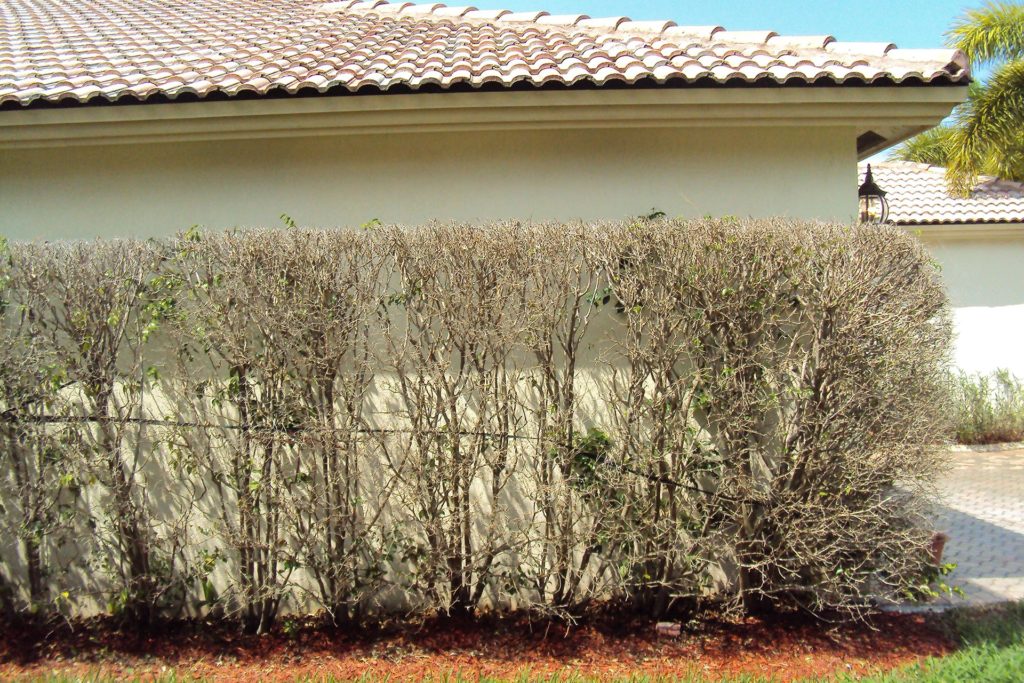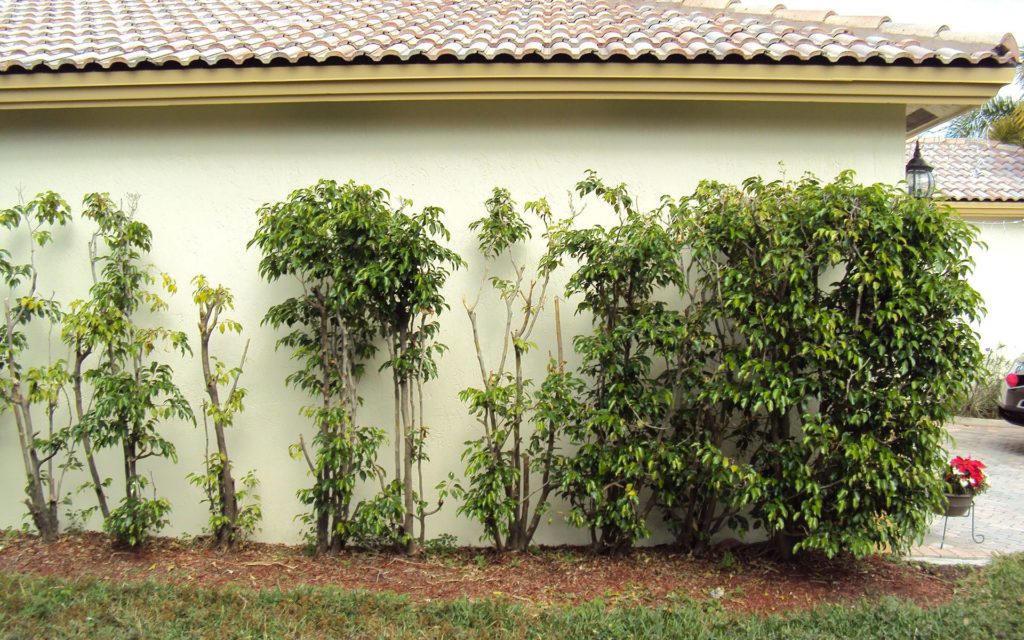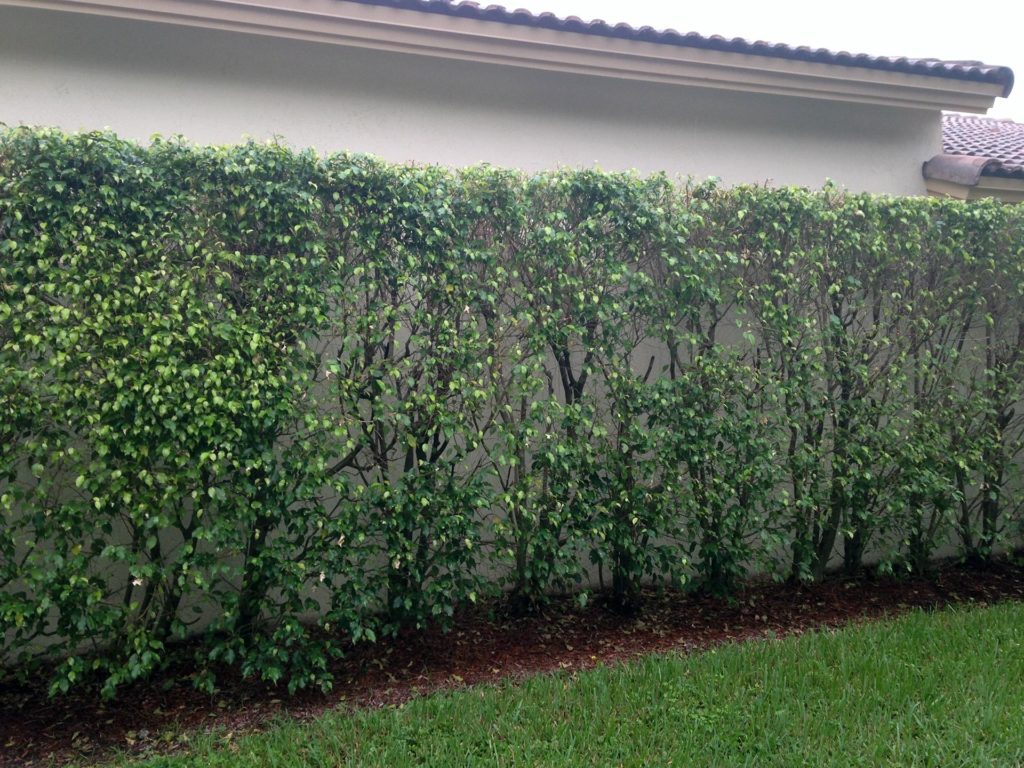Ficus Benjamina makes a great privacy hedge. Until ficus whitefly attacks them and causes the trees and hedges on your property to lose all of their leaves, Ficus whitefly damage can be prevented with the correct ficus whitefly control program. If you take precautionary measures, this way, you will never have to experience another bare ficus hedge again. Do you see substantial whitefly damage on your ficus? Don’t despair; there is hope. A 100% recovery of your privacy hedge is possible — all it will take some proper care and patience.
Ficus Whiteflies On Hedges

If your ficus hedges are properly treated twice a year with our exclusive whitefly prevention treatment, your ficus will be protected guaranteed. Even if adult whiteflies may be present around the fence from all your neighbor’s properties and they do not treat or protect their hedges.

Systemic insecticide treatments work better than ficus whitefly sprays since spray only lasts 7 to 14 days on the leaf. In contrast, one treatment guarantees to control whitefly six months guaranteed. Newly born whitefly nymphs must suck the blade the moment they are born and by sucking the plant material with the insecticide in it. It becomes their first and last meal, unable to become reproductive adults.
Helping you Ficus Hedge Thrive
Ficus benjamina hedges need full sunlight. Without having enough sunlight, ficus benjamina will never look good. Over trimming can cause ficus to look thin and sick, make sure that they are not over trimmed. but, ficus should be cut regularly, especially on the top to allow the sun to penetrate

We often see seen ficus privacy hedges not trimmed or overgrown; this causes the top growth to block sunlight, preventing the sunlight from reaching the lower leaves. Thin with fences provide no privacy and can be confused for whitefly damage.
Whiteflies On Ficus Hedge
Since 2009 when ficus whitefly first came to the sub-tropical regions like South Florida, Miami experienced the effects of whitefly damage.
When ficus shrubs and trees get infested by ficus whitefly, they drop their leaves as a response to protect themselves. Severe drought if no irrigation is present.
People worry if they see adult whiteflies present even after our treatment. Still, it is not the adult whiteflies that causes most of the whitefly damage. It is the immature nymph that is in the crawling stage.
People will often shake ficus benjamina bushes checking to see if adult whiteflies come out. However, the best indication you have an infestation of whiteflies is to look on the back of leaves for the molting cases. Ficus whiteflies are piercing-sucking insects and thus feed on leaves by sucking juices from the plant tissue and causing the plant not to have sufficient nutrients, with severe stress and causing leaf drop. After feeding the plant juices, ficus whitefly metabolizes and secrete a sugary substance called honeydew.
If you look closely at a severely infested leaf, you can see a shiny coated areas where the honeydew is. This sugar glucose substance allows for a black fungus called sooty mold to feed on the sugar and grow.
Sooty mold it is a sure-fire sign of whitefly or other insects piercing-sucking insects feeding on other plants or trees in the current area.
How To Prevent Ficus Whitefly Damage
Be proactive, not reactive; It is significantly more natural and less costly to prevent whitefly damage than it is to maintain a ficus in full health.
We were among the first pest control companies in South Florida to extensively test systemic whitefly treatment when it first appeared in 2009. With over 11 years and millions of square feet of ficus treated with no defoliation.

The best product for our type of soil is a systemic insecticide with the active ingredient imidacloprid.
Because imidacloprid is the least water-soluble of all types of pesticides in its category, it allows for the most extended control when applied as a root drench or soil injection.
Our particular application and formulation allow us to get you the most extended control possible without contaminating your landscape with ficus whitefly sprays. In all, we provide superior esthetics with less contamination making our longer-lasting service more eco-friendly.
Why don’t we use the granular imidacloprid?
While granular may be faster to apply, making a cheaper application method, there are problems with this application method. Landscapers could blow the product away soon after it was applied apart from the ficus base unto your neighbor’s lawn. The granular insecticide takes weeks do dissolve, and delays the uptake prolongs the damage to ficus. The mulched area will absorb most of the pesticide, preventing the hedge or tree from consuming it. Water from rain or irrigation could cause the product to run off. Making a root drench or root injection directly to ficus roots with a liquid application allows us to get you the best results faster since the product immediately available to the plant for immediate uptake through the roots.
In areas of Miami Dade where ficus hedges planted around the community, like in new community developments. Where the entire outside privacy fence, these will be areas with an extreme amount of whitefly action.
Stop falling prey to cheap, ineffective ficus whitefly spray service that contaminates your entire yard with no proven effectiveness.



